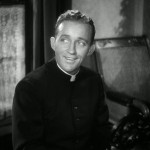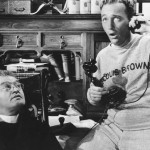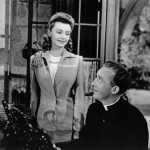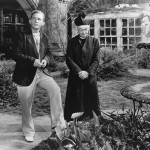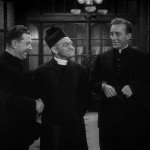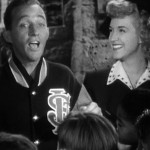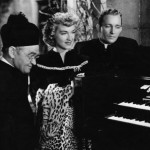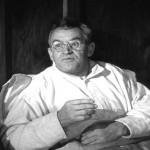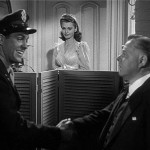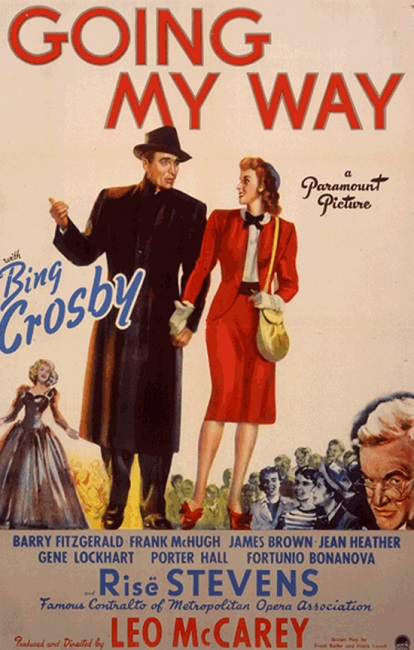
Going My Way – 1944
Here we come to Going My Way, a nice movie about an Irish Catholic priest named Father Charles “Chuck” O’Malley who is assigned to take over the financially failing church, St. Dominic’s. The elderly priest in residence is Father Fitzgibbon. Things seem hopeless, but then again, O’Malley is played by the biggest box office drawing actor of the 1940’s, Bing Crosby. Of course everything will be alright. Critics have called this film Crosby’s best, even putting it above such favorites as The Bells of St. Mary’s or White Christmas. Unfortunately, I can’t confirm or deny that appraisal. This is the first film starring Bing Crosby I have ever seen.
The movie was nominated for ten Academy Awards, winning seven of the coveted statuettes. Besides Best Picture, Crosby took home the Oscar for Best Actor. Fitzgibbon, played by Barry Fitzgerald, won for Best Supporting Actor, though he was also nominated for Best Actor, losing to Crosby. I’m still trying to reason that one out – Nominated for Best Actor and Best Supporting Actor for the same role. What if he had won them both? The film also won Awards for Best Director (Leo McCarey), Best Writing, Screenplay, Best Original Motion Picture Story, and Best Music, Song (more about that later).
The character of Father O’Malley was the kind of guy that was practically perfect in every way. He was written to be the priest we all wish we could have. He was kind and generous, smart and self-effacing, gentle and mild, funny and could sing like an angel. He had a great love for music, and a talent for composing, which, by the way, became a plot point in the story. You see, he finds that the best way for him to save the church from foreclosure is to write and sell a hit song.
He begins by starting a boy’s choir, recruiting the local hoodlums and teaching them to sing. But this is just set-up so that later in the film he will have a back-up choir to help him sell his hit song to the record producer, Max Dolan, played by William Frawley, otherwise known as Fred Mertz from I Love Lucy. He even has a connection to (and therefore the help of) the world famous opera star, Genevieve Linden, played by real life opera star Rise Stevens, who fronts the song for him. The plan works, but not in the way that O’Malley intends.
The title song, “Going My Way“, is his big hopeful, but Dolan turns it down, calling it too high-class and schmaltzy. As the record producer is leaving, Crosby sings the song “Swinging on a Star” with his pitch perfect hoodlum choir. Dolan hears it and decides to buy it on the spot. The Church is saved! The mortgage is paid and everyone is happy!
But none of it matters because the half church burns down in a fire.
Some elements of the plot vaguely reminded me of the 1992 movie Sister Act. A failing church is put back on the straight-and-narrow because of someone who breathes life back into it, using the gift of music. And I have to admit, Crosby sure had the gift. He was, of course, an accomplished actor, but I think he was just as well known as a singer. He had a beautiful baritone voice that was soft and velvety and perfectly even from his low to his high range. He sang five songs in the movie.
The title song was a beautiful tune that really lent itself to Crosby’s crooning style. But let’s face it – nobody today remembers it. Everyone, however, remembers “Swinging on a Star“. It has a delightful, catchy melody and cute lyrics. In fact, this is the song that won the Academy Award for Best Music, Song. As I watched the movie, I kept thinking that the movie should have been called Swinging on a Star, but I guess that would have given the little plot twist away.
All that, of course, was only the main story line of the plot. There were others. For example, there was a bit of drama that centered around Father Fitzgibbon as the doddering, elderly priest who had to step aside to make way for the spry, young one. As a matter of fact, Fitzgerald did a very good job as the aged clergyman. He was mildly crotchety, slightly cantankerous, and wonderfully endearing.
Another story line was that of Carol James, played by beautiful Jean Heather, a young woman who had run away from home and is suspected of being up to no good. So where do the police bring her? Why, to the church, of course. Father O’Malley helps her out with a little money and sends her on her way. She meets the handsome son of the banker behind the foreclosure of the church and marries him. To me, this little side story was so insignificant to the main plot that it is almost not even worth mentioning but I know exactly why it was part of the movie.
A few weeks after the couple are wed, the young man joins the military and goes off to war. Remember, this is still 1944 and World War II is not yet over. We can’t pass up the chance to display a handsome young man in his sharp military uniform fighting in the service of his country, his tearful young bride waiting for his return.
If I had any real criticism of Going My Way, it would be that the character of Father O’Malley was so noble and righteous, so godly and perfect, he was not really believable. A man like that would surely be given sainthood. I’m not saying that there aren’t actually people who are that good, but he didn’t seem to have a single flaw. Not one. Something, anything – a loss of temper, a bad habit, a dark past – would have made him seem more real to me.
This was another film that, while I enjoyed it, was a little too slow paced for my tastes. But it was good to finally see Bing Crosby in a film. I understand why he was such a popular actor.
Interesting note: After World War II, Bing Crosby and Leo McCarey presented a copy of the motion picture to Pope Pius XII at the Vatican.
